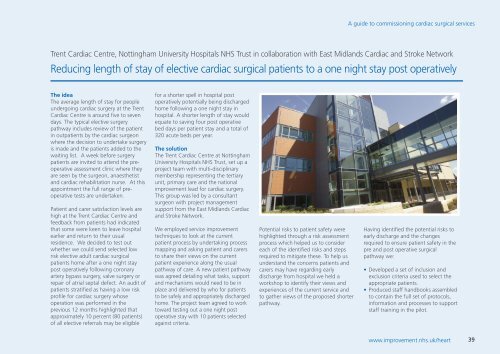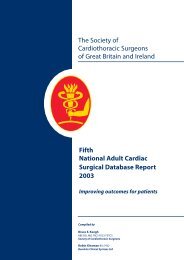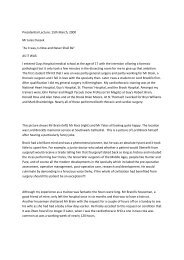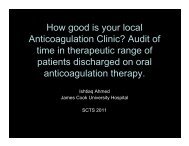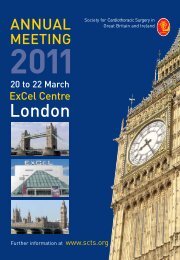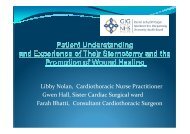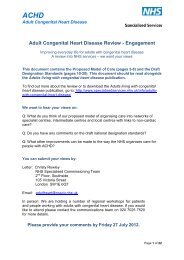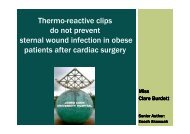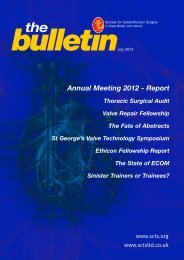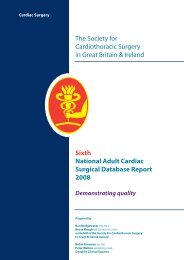A guide to commissioning cardiac surgical services - NHS ...
A guide to commissioning cardiac surgical services - NHS ...
A guide to commissioning cardiac surgical services - NHS ...
You also want an ePaper? Increase the reach of your titles
YUMPU automatically turns print PDFs into web optimized ePapers that Google loves.
A <strong>guide</strong> <strong>to</strong> <strong>commissioning</strong> <strong>cardiac</strong> <strong>surgical</strong> <strong>services</strong><br />
Trent Cardiac Centre, Nottingham University Hospitals <strong>NHS</strong> Trust in collaboration with East Midlands Cardiac and Stroke Network<br />
Reducing length of stay of elective <strong>cardiac</strong> <strong>surgical</strong> patients <strong>to</strong> a one night stay post operatively<br />
The idea<br />
The average length of stay for people<br />
undergoing <strong>cardiac</strong> surgery at the Trent<br />
Cardiac Centre is around five <strong>to</strong> seven<br />
days. The typical elective surgery<br />
pathway includes review of the patient<br />
in outpatients by the <strong>cardiac</strong> surgeon<br />
where the decision <strong>to</strong> undertake surgery<br />
is made and the patients added <strong>to</strong> the<br />
waiting list. A week before surgery<br />
patients are invited <strong>to</strong> attend the preoperative<br />
assessment clinic where they<br />
are seen by the surgeon, anaesthetist<br />
and <strong>cardiac</strong> rehabilitation nurse. At this<br />
appointment the full range of preoperative<br />
tests are undertaken.<br />
Patient and carer satisfaction levels are<br />
high at the Trent Cardiac Centre and<br />
feedback from patients had indicated<br />
that some were keen <strong>to</strong> leave hospital<br />
earlier and return <strong>to</strong> their usual<br />
residence. We decided <strong>to</strong> test out<br />
whether we could send selected low<br />
risk elective adult <strong>cardiac</strong> <strong>surgical</strong><br />
patients home after a one night stay<br />
post operatively following coronary<br />
artery bypass surgery, valve surgery or<br />
repair of atrial septal defect. An audit of<br />
patients stratified as having a low risk<br />
profile for <strong>cardiac</strong> surgery whose<br />
operation was performed in the<br />
previous 12 months highlighted that<br />
approximately 10 percent (80 patients)<br />
of all elective referrals may be eligible<br />
for a shorter spell in hospital post<br />
operatively potentially being discharged<br />
home following a one night stay in<br />
hospital. A shorter length of stay would<br />
equate <strong>to</strong> saving four post operative<br />
bed days per patient stay and a <strong>to</strong>tal of<br />
320 acute beds per year.<br />
The solution<br />
The Trent Cardiac Centre at Nottingham<br />
University Hospitals <strong>NHS</strong> Trust, set up a<br />
project team with multi-disciplinary<br />
membership representing the tertiary<br />
unit, primary care and the national<br />
improvement lead for <strong>cardiac</strong> surgery.<br />
This group was led by a consultant<br />
surgeon with project management<br />
support from the East Midlands Cardiac<br />
and Stroke Network.<br />
We employed service improvement<br />
techniques <strong>to</strong> look at the current<br />
patient process by undertaking process<br />
mapping and asking patient and carers<br />
<strong>to</strong> share their views on the current<br />
patient experience along the usual<br />
pathway of care. A new patient pathway<br />
was agreed detailing what tasks, support<br />
and mechanisms would need <strong>to</strong> be in<br />
place and delivered by who for patients<br />
<strong>to</strong> be safely and appropriately discharged<br />
home. The project team agreed <strong>to</strong> work<br />
<strong>to</strong>ward testing out a one night post<br />
operative stay with 10 patients selected<br />
against criteria.<br />
Potential risks <strong>to</strong> patient safety were<br />
highlighted through a risk assessment<br />
process which helped us <strong>to</strong> consider<br />
each of the identified risks and steps<br />
required <strong>to</strong> mitigate these. To help us<br />
understand the concerns patients and<br />
carers may have regarding early<br />
discharge from hospital we held a<br />
workshop <strong>to</strong> identify their views and<br />
experiences of the current service and<br />
<strong>to</strong> gather views of the proposed shorter<br />
pathway.<br />
Having identified the potential risks <strong>to</strong><br />
early discharge and the changes<br />
required <strong>to</strong> ensure patient safety in the<br />
pre and post operative <strong>surgical</strong><br />
pathway we:<br />
• Developed a set of inclusion and<br />
exclusion criteria used <strong>to</strong> select the<br />
appropriate patients.<br />
• Produced staff handbooks assembled<br />
<strong>to</strong> contain the full set of pro<strong>to</strong>cols,<br />
information and processes <strong>to</strong> support<br />
staff training in the pilot.<br />
www.improvement.nhs.uk/heart<br />
39


